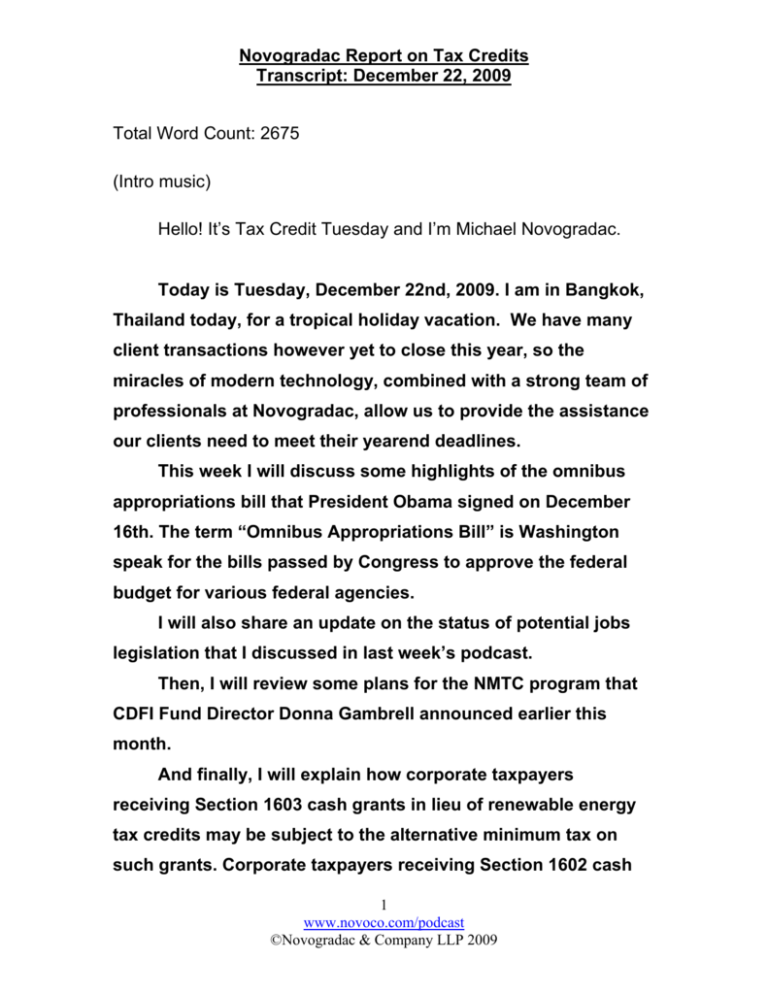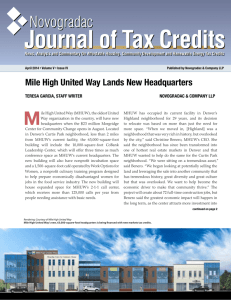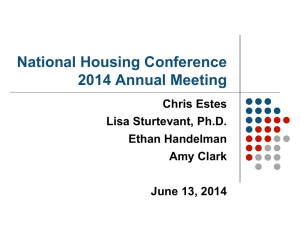
Novogradac Report on Tax Credits
Transcript: December 22, 2009
Total Word Count: 2675
(Intro music)
Hello! It’s Tax Credit Tuesday and I’m Michael Novogradac.
Today is Tuesday, December 22nd, 2009. I am in Bangkok,
Thailand today, for a tropical holiday vacation. We have many
client transactions however yet to close this year, so the
miracles of modern technology, combined with a strong team of
professionals at Novogradac, allow us to provide the assistance
our clients need to meet their yearend deadlines.
This week I will discuss some highlights of the omnibus
appropriations bill that President Obama signed on December
16th. The term “Omnibus Appropriations Bill” is Washington
speak for the bills passed by Congress to approve the federal
budget for various federal agencies.
I will also share an update on the status of potential jobs
legislation that I discussed in last week’s podcast.
Then, I will review some plans for the NMTC program that
CDFI Fund Director Donna Gambrell announced earlier this
month.
And finally, I will explain how corporate taxpayers
receiving Section 1603 cash grants in lieu of renewable energy
tax credits may be subject to the alternative minimum tax on
such grants. Corporate taxpayers receiving Section 1602 cash
1
www.novoco.com/podcast
©Novogradac & Company LLP 2009
Novogradac Report on Tax Credits
Transcript: December 22, 2009
grants in lieu of low-income housing tax credits could be facing
a similar issue.
But first, I have three breaking news items about various
tax legislative proposals.
The first is a tax proposal to expand the renewable energy
manufacturing tax credit under Section 48C.
On December 16th, Vice President Joseph Biden introduced a
proposal to revitalize manufacturing and the proposal includes
supports for the expansion of the Section 48C renewable energy
manufacturing tax credit.
The advanced energy manufacturing tax credit was created by
the Recovery Act and it supports the building and equipping of new,
expanded or retooled factories that manufacture the products needed
to power the green economy. Before the Recovery Act was passed in
February, all domestic tax incentives focused exclusively on business
and consumer tax credits to encourage the use of technology such as
solar panels. The manufacturing tax credit created under Section
48C, for the first time incentivized companies to manufacture clean
technologies in the United States.
The Recovery Act included $2.3 billion in renewable energy
manufacturing tax credits. This amount is expected to support more
than $7.5 billion in total capital investment. The program generated
considerable interest and has been significantly oversubscribed.
2
www.novoco.com/podcast
©Novogradac & Company LLP 2009
Novogradac Report on Tax Credits
Transcript: December 22, 2009
In last week’s proposal the Administration announced its
support for expanding the program by as much as $5 billion.
Following Vice President Biden’s announcement, New Mexico
Senator Jeff Bingaman released a statement applauding the White
House for supporting his call to expand the tax credit.
Senator Bingaman coauthored the tax credit program, and as I
discussed in the December 1st podcast, he recently called for the
credit authority to be doubled. On December 10th Senator Bingaman
introduced S. 2857, the American Clean Technology Manufacturing
Leadership Act. S. 2857 is a bipartisan bill that would add an
additional $2.5 billion in tax credits, enough to leverage $8.33 billion
in new domestic investment.
Senator Bingaman chairs the Finance Subcommittee on
Energy, Natural Resources and Infrastructure, and plans to convene
a hearing in early 2010 on tax incentives for energy manufacturing.
Michigan Senator Debbie Stabenow, who co-authored the tax
credit with Senator Bingaman, also applauded the White House’s
support for expanding the renewable energy manufacturing tax credit.
She said, and I quote: “This initiative is central to any jobs
package, and I am pleased the White House has endorsed an
expansion of this credit. We have a long line of manufacturers that
have applied for the credit, manufacturers that are going to be able to
put people to work.” Close quote.
Senate Finance Committee Chairman Max Baucus of Montana
also released a statement last week in support of expanding the
3
www.novoco.com/podcast
©Novogradac & Company LLP 2009
Novogradac Report on Tax Credits
Transcript: December 22, 2009
credit. In that statement he described the credit as a highly effective
tax measure. He said, and Iquote: “We have kept a close eye on
implementation of this credit, both in terms of energy independence
and for creating jobs, and the results are encouraging. These energy
investment tax credits will help to keep our alternative energy sector
moving forward, growing jobs at home and leadership abroad as we
confront the demand for clean, renewable energy.” close quote
To follow this proposal and other renewable energy tax credit
news, please visit www.energytaxcredits.com. You can also receive
updates by subscribing to our free Industry Alert emails, by following
us on Twitter, and in future podcasts.
The second tax proposal is a bill to extend Section 1603
which gives taxpayers the ability to receive cash grants in lieu of
renewable energy tax credits.
On December 17th, Senators Dianne Feinstein, Democrat of
California, and Jeff Merkley, a Democrat from Oregon, introduced S.
2899, legislation that would extend the Section 1603 cash grant
program for two additional years, until 2012. S. 2899 would also
expand the Section 1603 program to allow public power utilities to
participate and to create a new tax credit for solar manufacturing
facilities and the construction of large solar projects on disturbed
private lands.
The third breaking news tax proposal comes from the
Senate Health bill.
4
www.novoco.com/podcast
©Novogradac & Company LLP 2009
Novogradac Report on Tax Credits
Transcript: December 22, 2009
In the bill, the health insurance tax rate for high income tax
payers would increase by 0.9 percent. If passed, this increase in
health care taxes on high income taxpayers would raise over $86
billion.
Now for a quick review of the federal appropriations that
were signed into law last week.
On December 16th, President Obama signed into law H.R.
3288, an omnibus appropriations measure that combines six major
spending bills. The final package provides:
y approximately $64 billion for Commerce, Justice and
Science;
y $68 billion for Transportation, Housing and Urban
Development;
y $24 billion for Financial Services;
y $163 billion for Labor, Health and Human Services and
Education;
y $78 billion for Military Construction and Veterans Affairs;
y and $48 billion for State and Foreign Operations.
In the Treasury Department funding section, the bill provides
almost $247 million of resources in fiscal year 2010 for the
Community Development Financial Institutions or CDFI Fund’s
programs. The fiscal year 2010 appropriation is the largest ever for
the CDFI Fund.
Overall, the omnibus bill provides $46.1 billion in discretionary
funding for HUD, $4.2 billion - or 12 percent - above the fiscal year
5
www.novoco.com/podcast
©Novogradac & Company LLP 2009
Novogradac Report on Tax Credits
Transcript: December 22, 2009
2009 spending level. To learn more about the specific amounts for
each HUD program, I invite you to visit Novogradac & Company’s
HUD Resource Center. It’s web site is at
www.hudresourcecenter.com. A chart of funding by program is
available along with other relevant information. Just click on HUD
Budget in the HUD menu.
One thing to note is that the $1 billion that was requested in the
President’s budget for the National Housing Trust Fund was not,
unfortunately was not, included in the HUD appropriations bill.
However, the National Housing Trust Fund was funded in the Jobs for
Main Street Act, which brings us to our next topic for today.
On December 15th the Jobs for Main Street Act was
introduced in the House. It was an amendment to H.R. 2847,
which is an appropriations bill.
The bill includes more than $150 billion in targeted investments
intended to spur job creation and to provide funds for various
infrastructure projects. The House passed the bill on December 16th
by a close vote of 217 to 212.
The jobs bill redirects $75 billion from the Troubled Asset Relief
Program or TARP to fund a number of congressional priorities,
including the National Housing Trust Fund. The bill includes $1 billion
for the National Housing Trust Fund and that fund will provide
communities with funds to build, preserve and rehabilitate rental
homes that are affordable for extremely low and very low-income
6
www.novoco.com/podcast
©Novogradac & Company LLP 2009
Novogradac Report on Tax Credits
Transcript: December 22, 2009
households. The bill also provides $65 million for project-based
vouchers to support units built by the trust fund.
The Senate continues to be consumed by health-care reform
legislation, as certainly all of our listeners know, and is not expected
to take up a jobs bill until the Senators return in January.
The LIHTC consensus proposals are not currently included in
the House passed version of the jobs bill but there are a number of
opportunities that remain for them to be added either in the Senate
bill or in a rumored second installment of jobs provisions from the
House.
Let’s shift gears now to consider what lies ahead for the
New Markets Tax Credit program.
On December 10th, CDFI Fund Director Donna Gambrell spoke
to attendees at the New Markets Tax Credit Coalition’s 8th Annual
Conference. In her remarks, Director Gambrell discussed some of the
challenges that the CDFI Fund is facing and how they plan to
respond.
Director Gambrell said there are real concerns about investor
willingness to make qualified equity investments for available NMTCs.
She said the CDFI Fund has been closely monitoring the investment
market for New Markets Tax Credits and reports that during the oneyear period ending November 30, 2009, community development
entities have raised 27 percent less capital than in same one-year
period the year before. In addition, she said that 2009 will almost
7
www.novoco.com/podcast
©Novogradac & Company LLP 2009
Novogradac Report on Tax Credits
Transcript: December 22, 2009
certainly be the first year in which investments into CDEs declines
from the prior year.
Director Gambrell said the CDFI Fund is responding to these
trends in a number of ways. For example, she said the CDFI Fund,
through its new Office of Training and Outreach, is reaching out to
potential investors who have not been active in New Markets
investing.
Second, she says the CDFI Fund is actively working within the
Treasury Department and with the IRS on regulatory changes and
clarifications that would result in greater investor confidence, such as
allowing NMTC investments to be used as an offset against the
alternative minimum tax or AMT.
In addition, the CDFI Fund continues to work with the
administration on reauthorizing the program further into the future
which would also yield more investor confidence in the program, and
more investor interest.
Director Gambrell also updated attendees at the conference on
what to expect for the 2010 round. She said the Fund is currently
considering public comments that were submitted to the CDFI Fund
regarding the NMTC allocation application, comments including those
submitted by the New Markets Tax Credit Working Group; the goal is
to include what they can as part of the 2010 application round.
She also announced that because the CDFI Fund is launching
a new Capital Magnet Fund and a new Financial Education and
Counseling Pilot Program in 2010, the timing of the next round of the
8
www.novoco.com/podcast
©Novogradac & Company LLP 2009
Novogradac Report on Tax Credits
Transcript: December 22, 2009
NMTC program will have to be modified. As a result, Director
Gambrell said the CDFI Fund anticipates that the 2010 round will
open in the spring of 2010 and that the awards would likely not be
announced until roughly December, certainly before the end of the
year, but more likely December.
Our final topic for this week is the AMT treatment of two
grant programs created by the Recovery Act.
BNA reported earlier this month that the Section 1603 Grant-inLieu of Tax Credit may be subject in certain cases to the federal
corporate alternative minimum tax. According to ACORE member
Michael Faber, the cash grants awarded under the Section 1603,
that’s a program that allows cash grants in lieu of renewable energy
tax credits, may be subject in certain cases to the 20 percent
corporate AMT at an effective rate that could range from 7.5 percent
to as high as 15 percent. Mr. Faber is a partner at the law firm Wilson
Sonsini Goodrich & Rosati.
The Section 1602 program that provides cash grants in lieu of
low-income housing tax credits could face a similar issue.
In calculating liability for AMT, a C corporation makes
adjustments to taxable income such as the addition of 75 percent of
quote “adjusted current earnings” in excess of the corporation’s AMT
income.
The Internal Revenue Code under Section 56(g)(4)(B)(i)
provides that adjusted current earnings includes amounts that are
otherwise excluded from gross income for purposes of computing
9
www.novoco.com/podcast
©Novogradac & Company LLP 2009
Novogradac Report on Tax Credits
Transcript: December 22, 2009
AMT income but which are taken into account for purposes of
computing the corporation's earnings and profits.
Therefore you look to Regulation Section 1.312-6(b), wherein
the Treasury Regulations state that earnings and profits include all
income exempted by statute. This rule could mean that you pick up
items like tax-exempt grants under Section 1603 or Section 1602.
The Treasury Regulations provide that adjusted current earnings
generally do include income items that are permanently excluded
from pre-adjusted current earnings adjustments AMT income quote
"but that are taken into account in determining earnings and profits."
close quote. Because at least 50 percent of a Section 1603 or
Section 1602 grant is permanently excluded from income, but is
included in determining earnings and profits, 75 percent of that
portion of the grant would be included in the adjusted current
earnings adjustment, and could result in or increase the corporate
AMT.
The tax technical corrections bill introduced in the House earlier
this month would fix this issue for Section 1603 grants. However, the
provision currently included in the technical corrections bill would not
extend to grants under Section 1602.
Now it’s time for this week’s Project Profile segment.
The Railton, The Salvation Army's affordable downtown
housing development, reopened in downtown St. Louis, Missouri on
November 12th. The Salvation Army used historic tax credit and lowincome housing tax credit equity to complete a $14 million
10
www.novoco.com/podcast
©Novogradac & Company LLP 2009
Novogradac Report on Tax Credits
Transcript: December 22, 2009
rehabilitation of the building, which it has owned for more than 70
years. The Salvation Army reports that the renovation was prompted
by increasing maintenance costs and the facility’s rapid approach to
functional obsolescence.
Renovations included the transformation of the units from single
rooms to full apartments. Each unit features a kitchen and living
space. The Railton offers residents a computer center, fitness facility
and meeting spaces.
Several organizations assisted with the redevelopment of the
building, including Community Program Development Corporation,
McCormack Baron Ragan, National City Bank/PNC, Paric, St. Louis
Equity Fund and Trivers Associates.
This project will be discussed in more detail in the Historic Tax
Credit briefs in the January issue of the Novogradac Journal of Tax
Credits. The redesigned and expanded Journal includes a number of
historic tax credit features, including a monthly Q&A on technical
topics by my partners Tom Boccia and Charlie Rhuda and a monthly
column by John Leith-Tetrault who will write about a range of historic
tax credit topics, such as updates from the Historic Tax Credit
Coalition. To learn more about the Novogradac Journal of Tax
Credits, please visit www.novoco.com.
And before we wrap up, let’s take a look at the Tax Credit
Calendar.
11
www.novoco.com/podcast
©Novogradac & Company LLP 2009
Novogradac Report on Tax Credits
Transcript: December 22, 2009
This January does have a number of LIHTC events,
followed by the Novogradac New Markets Tax Credit conference
that ends themonth in San Diego.
The week of January 10th starts with the National Council of
State Housing Agencies’ annual HFA Institute, which has LIHTC
sessions the early part of that week. Their event is in Washington,
D.C. at the JW Marriott hotel. Go to www.ncsha.org for details.
Our Novogradac LIHTC developers conference is the end of
that week in Miami, Florida. For details, visit
www.taxcredithousing.com. I’ll be there, I hope to see you there as
well.
The Affordable Housing Tax Credit Coalition, of which I am a
board member, has their annual January conference in Laguna
Beach, California starting Tuesday, January 26th.
The end of that week, we at Novogradac will host our New
Markets Tax Credit Conference in San Diego, California. With the
recent NMTC announcement awards, and signed allocation
agreements out, this promises to be a well-attended conference of
CDEs looking for investments, and businesses seeking to receive
investments. We also expect a number of attendees to be there who
plan to apply for NMTCs in the next round, which we think will be
April 2010 as a due date.
Well, that brings me to the end of this week’s report.
12
www.novoco.com/podcast
©Novogradac & Company LLP 2009
Novogradac Report on Tax Credits
Transcript: December 22, 2009
Please join me again next week when I will discuss the latest
news of interest to the affordable housing, community development
and renewable energy communities.
This is Michael Novogradac and I’ll be back next Tuesday.
Thanks for listening.
(outro music)
Editorial material in this transcript is for informational purposes
only and should not be construed otherwise. Advice and
interpretation regarding tax credits or any other material covered in
this transcript can only be obtained from your tax advisor.
© Novogradac & Company LLP, 2009 All rights reserved.
Reproduction of this publication in whole or in part in any form
without written permission from the publisher is prohibited by law. For
reprint information, please send an e-mail to cpas@novoco.com.
13
www.novoco.com/podcast
©Novogradac & Company LLP 2009








